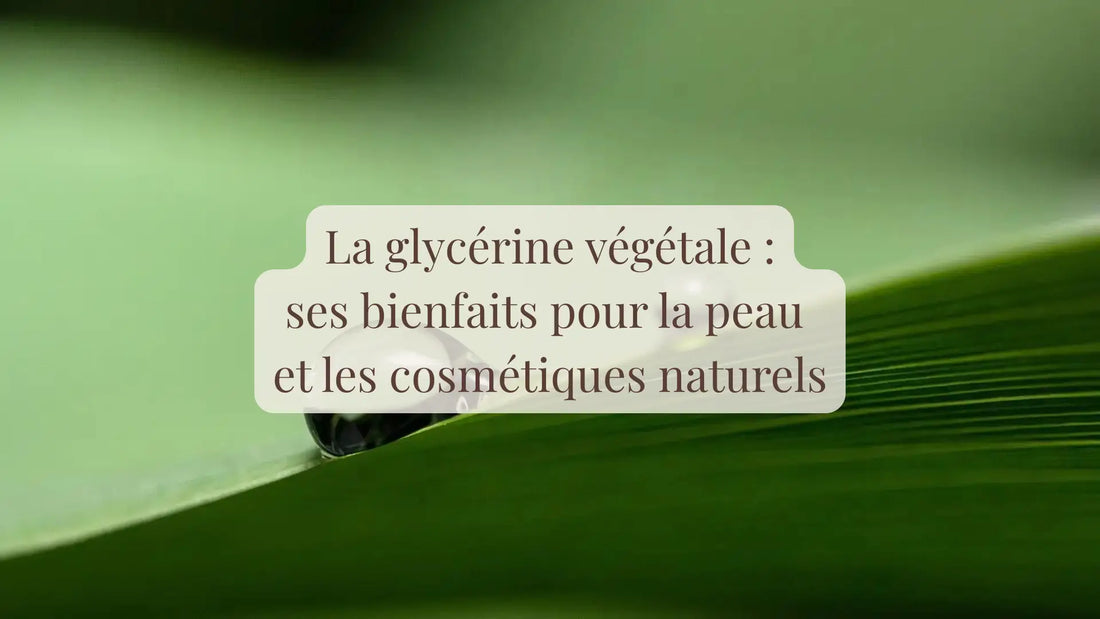
Vegetable glycerin: benefits for skin and natural cosmetics
share
Skin can sometimes lack water, become uncomfortable, feel tight, or lose its radiance. Unlike dry skin (which is a skin type in itself), dehydration is a temporary condition that can affect all skin types, even the oiliest. It is often linked to overly aggressive skincare, frequent cleansing, or an unsuitable routine, which weaken the skin's natural protective film and increase water loss.
Vegetable glycerin occupies a prominent place among the gentle and effective ingredients for restoring skin comfort. A natural humectant, it attracts and retains water in the skin's surface layers, helping to maintain hydration. This is why it's found in many of our skincare products.
The origin of glycerin
A historical discovery
Glycerin, also known as glycerol, was discovered in 1779 by Swedish chemist Carl Wilhelm Scheele. He isolated it by heating a mixture of olive oil and litharge (lead oxide), marking the beginning of the exploration of this substance with its many applications. Today, glycerin is ubiquitous in various fields, including cosmetics, food, and pharmacy.
Sources and Types of Glycerin
Glycerin can be of plant, animal, or synthetic origin. In cosmetics, preference is generally given to vegetable glycerin, extracted from oils such as rapeseed, soybean, sunflower, or palm. This substance appears as a viscous, colorless, odorless liquid with a slightly sweet taste. It is highly soluble in water and has humectant properties, making it a prime ingredient for moisturizing the skin. Synthetic glycerin, on the other hand, is produced from petrochemical derivatives such as propylene, but is less popular in natural or organic formulations.
The processes for obtaining glycerin
Glycerin can be obtained through several processes, all involving the transformation of fats (vegetable, animal, or petrochemical). The two main methods used in the cosmetics and food industries are transesterification and saponification.
Transesterification
Transesterification is a chemical process widely used in the production of biodiesel. It involves reacting a vegetable oil (or animal fat) with an alcohol (usually methanol or ethanol), in the presence of a catalyst such as sodium hydroxide (NaOH) or potassium hydroxide (KOH). This reaction produces two components: methyl esters (biodiesel) and glycerol as a by-product.
The glycerin obtained by transesterification is then purified by various processes (distillation, filtration, chromatography) to achieve pharmaceutical or cosmetic quality, depending on the final use. This process is very widespread for the large-scale production of vegetable glycerin.
Cold saponification
Cold saponification is an artisanal method of soap making, which takes place at a moderate temperature (around 40 to 50°C). It is based on an exothermic reaction between a fatty substance (vegetable oil) and a base (often sodium hydroxide, NaOH).
Unlike hot saponification, this technique allows the glycerin to be naturally preserved in the soap , without extracting it. This gentle process preserves the properties of vegetable oils and any additions (essential oils, plant extracts) while giving rise to a rich, moisturizing and skin-friendly soap.
Hot saponification
Hot process soap making involves heating a mixture of fatty substances and a base (often potash or soda) to a high temperature, usually between 80°C and 100°C. This method speeds up the chemical reaction, allowing for faster soap production.
In this case, the glycerin formed can be partially extracted or retained in the final product, depending on the formulation objectives. This method is used in the manufacture of certain traditional soaps such as Marseille soap.
Glycerin for Skin: Benefits, Uses, and Recommendations for Your Skin Type
Vegetable glycerin is an exceptional moisturizing ingredient widely used in skin care. It helps retain water in cells, strengthens the skin barrier, and soothes sensitive or damaged skin.
Why does skin become dry? The role of sebum and the skin barrier
Almost everyone has drier areas on their body or face. Skin naturally dries out when it lacks water. With age, sebum production decreases: this natural lipid film protects the epidermis from drying out and external aggressions.
A lack of sebum makes skin duller, rougher to the touch, less supple, and less elastic. This sebum contains fatty acids and lactic acid, which contribute to skin pH balance and strengthen natural protection against bacteria.
Glycerin is ideal for helping the skin regain softness, comfort and deep hydration.
Skin care with glycerin: adapt to each skin type
Dehydrated Combination Skin: How to Balance Hydration and Excess Sebum
Combination skin has both oily areas (often the T-zone: forehead, nose, chin) and drier or dehydrated areas. It can be sensitized by aggressions such as pollution, wind, sun or overly aggressive cleansing.
In this case, it is important to opt for moisturizing and mattifying treatments , capable of regulating excess sebum while nourishing the drier areas.
Recommended handmade soaps for combination skin :
- Lime soap : purifying and balancing, perfect for the T-zone
- Tea tree soap : antioxidant, purifying, ideal for regulating
- Orange Blossom Soap : Gentle and soothing for dry areas
- Mango and pineapple soap : revitalizing, perfect for restoring shine without leaving skin greasy
Dry and dehydrated skin: the best nourishing soaps with glycerin
Dry skin lacks water, but also lipids. It becomes uncomfortable after washing, feels tight, itchy, and quickly loses its suppleness. This phenomenon worsens with age, as the lipid barrier thins.
To restore balance to dry skin, it is essential to choose products rich in moisturizing and nourishing agents such as glycerin, shea butter or vegetable oils.
Recommended handmade soaps for dry skin :
- Ayurvedic soap : nourishing and moisturizing
- Avocado soap : restorative and rich in fatty acids
- Honey soap : radiant and softening
- Calendula soap : soothing, perfect for sensitive skin
- Goat's milk soap : ultra-nourishing and softening
Oily and dehydrated skin: purify without damaging it thanks to glycerin
Oily skin is characterized by overproduction of sebum, excessive shine, enlarged pores and frequent imperfections (blackheads, pimples). But it can also be dehydrated , particularly due to overly aggressive cleansers, stress or pollution.
Even oily skin needs hydration! Balancing and purifying glycerin-based skincare products help maintain skin suppleness while regulating sebum.
Recommended handmade soaps for oily skin :
- Activated charcoal soap : purifying, detoxifying, anti-blemish
- Sulfur soap : antibacterial, ideal against acne
- Pumice Stone Soap : Exfoliating and Deep Cleansing
Vegetable Glycerin for Hair: A Natural Solution for Dry Hair
Glycerin isn't just good for your skin: it works wonders for your hair too! Particularly useful for dry, dull, or heat-damaged hair (hair dryers, straighteners), it helps retain moisture in the hair fiber.
Used in certain solid shampoos, hair care products, and homemade recipes, glycerin restores suppleness, shine, and softness to hair. It forms a light protective film around the hair without weighing it down.
For a homemade treatment : mix a tablespoon of vegetable glycerin with aloe vera or a vegetable oil (jojoba, avocado), apply as a mask 30 minutes before shampooing.
In summary: why choose vegetable glycerin-based treatments?
Versatile and natural, vegetable glycerin is a key ingredient in many everyday products. It is found in cosmetics (soaps, creams, shampoos) as well as in pharmacies, in syrups and oral care products. Moisturizing, softening, and protective, it helps the skin maintain suppleness and elasticity, while strengthening its natural barrier against external aggressions.
Its presence in artisanal soaps is particularly valuable: it gives them a soft texture, a soothing effect and real comfort of use, day after day.
A little tip if you're making your own cosmetics: make sure you follow the dosages carefully! Too much glycerin can sometimes dry out the skin, especially in leave-in products.
Photo credit: İbrahim Özkadir on Pixabay
Sources:
https://www.ajouts-alimentaires.net/
https://www.quechoisir.org/comparatif-ajouts-alimentaires-n56877/e422-glycerol-glycerine-p223661
https://www.pnrpe.fr/ajouts-alimentaires/autres/e422-glycerol
https://www.santemagazine.fr/alimentation/ajouts-alimentaires/glycerol-e422-169977
https://www.flow-savonnerie.com/dossier/savon-glycerine-avantages-peau/




